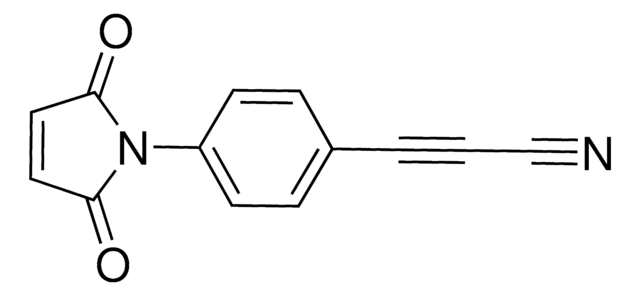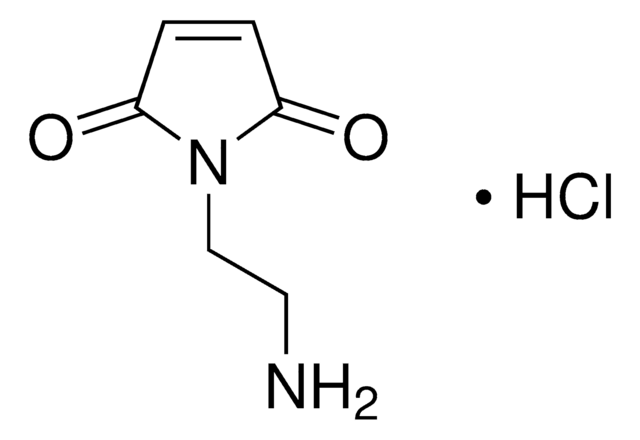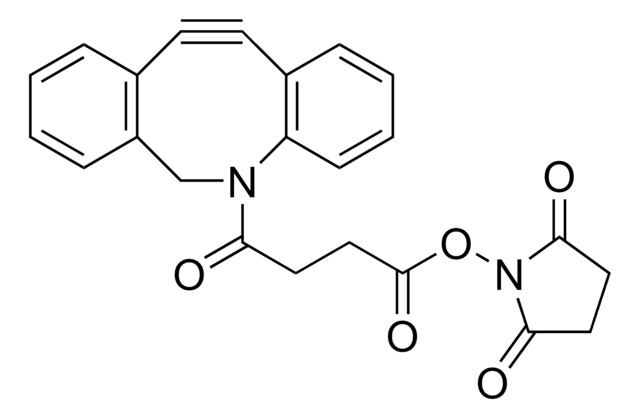807664
CBTF
Sinónimos:
APN-TFS ester, Sodium 4-((4-(cyanoethynyl)benzoyl)oxy)-2,3,5,6-tetrafluorobenzenesulfonate
About This Item
Productos recomendados
Formulario
powder
Nivel de calidad
idoneidad de la reacción
reagent type: cross-linking reagent
grupo funcional
ester
temp. de almacenamiento
−20°C
cadena SMILES
O=C(OC1=C(F)C(F)=C(S(=O)(O[Na])=O)C(F)=C1F)C2=CC=C(C#CC#N)C=C2
InChI
1S/C16H5F4NO5S.Na/c17-10-12(19)15(27(23,24)25)13(20)11(18)14(10)26-16(22)9-5-3-8(4-6-9)2-1-7-21;/h3-6H,(H,23,24,25);/q;+1/p-1
Clave InChI
YFJYSJRZDOWXDH-UHFFFAOYSA-M
Descripción general
Aplicación
Otras notas
- Dissolve the protein in an appropriate buffer* with pH 7.5-9.0 (e.g. PBS) at 1-10mg/mL concentration.
- Apply the appropriate amount of the stock solution of the reagent (1-5 molar eq. per lysine residue).
- Incubate at room temperature for 2 hours.
- If necessary, purify the protein-APN conjugate using size exclusion chromatography or ultrafiltration.
- The conjugate can be readily coupled with thiol-containing substrates by incubating the components in aqueous buffer (pH 6.5-9.0) at ambient temperature for 2 hours.
Standard protein labeling procedure (cysteine labeling):
Dissolve the protein in the appropriate buffer* with pH 6.5-9.0 (e.g. PBS) at 1-10mg/mL concentration.
Apply the appropriate amount of the stock solution of the APN-labeled molecule (1-5 molar eq. per free cysteine residue).
Incubate at room temperature for 2 hours.
If necessary, purify the protein conjugate using size exclusion chromatography or ultrafiltration.
*Note: avoid amine- and thiol-containing buffers.
Palabra de señalización
Danger
Frases de peligro
Consejos de prudencia
Clasificaciones de peligro
Acute Tox. 3 Oral
Código de clase de almacenamiento
6.1C - Combustible acute toxic Cat.3 / toxic compounds or compounds which causing chronic effects
Clase de riesgo para el agua (WGK)
WGK 3
Punto de inflamabilidad (°F)
Not applicable
Punto de inflamabilidad (°C)
Not applicable
Elija entre una de las versiones más recientes:
¿Ya tiene este producto?
Encuentre la documentación para los productos que ha comprado recientemente en la Biblioteca de documentos.
Los clientes también vieron
Nuestro equipo de científicos tiene experiencia en todas las áreas de investigación: Ciencias de la vida, Ciencia de los materiales, Síntesis química, Cromatografía, Analítica y muchas otras.
Póngase en contacto con el Servicio técnico![LC-SPDP (succinimidyl 6-[3(2-pyridyldithio)propionamido]hexanoate)](/deepweb/assets/sigmaaldrich/product/structures/300/586/d95fd80c-e201-4b0b-8aee-31e109c2ff41/640/d95fd80c-e201-4b0b-8aee-31e109c2ff41.png)









![(1R,8S,9s)-Bicyclo[6.1.0]non-4-yn-9-ylmethyl N-succinimidyl carbonate for Copper-free Click Chemistry](/deepweb/assets/sigmaaldrich/product/structures/969/022/d6776082-2f7a-47c7-bcd4-3830dac0fb7d/640/d6776082-2f7a-47c7-bcd4-3830dac0fb7d.png)
